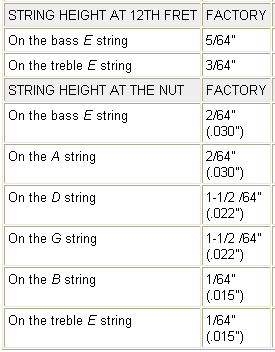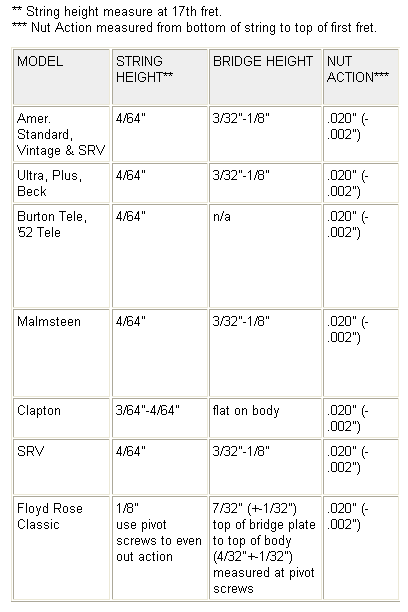Guitar Action and Relief
1994
Excerpted from
Setup Secrets of Fender, Gibson & Martin
It's cool but uses a lot of StewMac tools that are not necessary.
For most electrics, string height is adjusted by raising or lowering the
entire bridge, as in the case of the Gibson Tune-o-matic style, or by
adjusting the individual saddles of a Fender-style bridge. The simplest
way to set the action is to just lower the bridge until the strings
buzz, and then gradually raise it until the buzzing stops or is no
longer bothersome. Do this by eye until it feels good. The factory specs
are a good point to start from or return to during setup. See below:
GIBSON

FENDER

MARTIN

|
2009
Gibson factory set-up specs
from the Gibson-Talk.com forum
ACTION: adjusted by changing the nut slots, bridge height, and neck relief
• Fret E strings at the first fret and measure the distance
from the bottom of the string to the top of the 15th fret.
• Low E should be 5/64".
• High E should be 3/64".
Now measure the string heights at the nut to the first fret.
• Low E and A should measure 2/64"
• D and G =1.5/64"
• B and high E = 1/64"
• If string height at nut is correct, recheck string height at 12th fret with strings open.
• Measurement for low and high E's should be the same as measurement taken at the 15th.
NECK RELIEF: adjusted by turning the Truss Rod nut and tuning to pitch
• Fret the low E at the first and 15th fret (not 12th)
• Reach to the 7th fret and tap string.
There should be a small space between string and fret
no thicker than a piece of paper.
• Do the same with the high E.
|
|